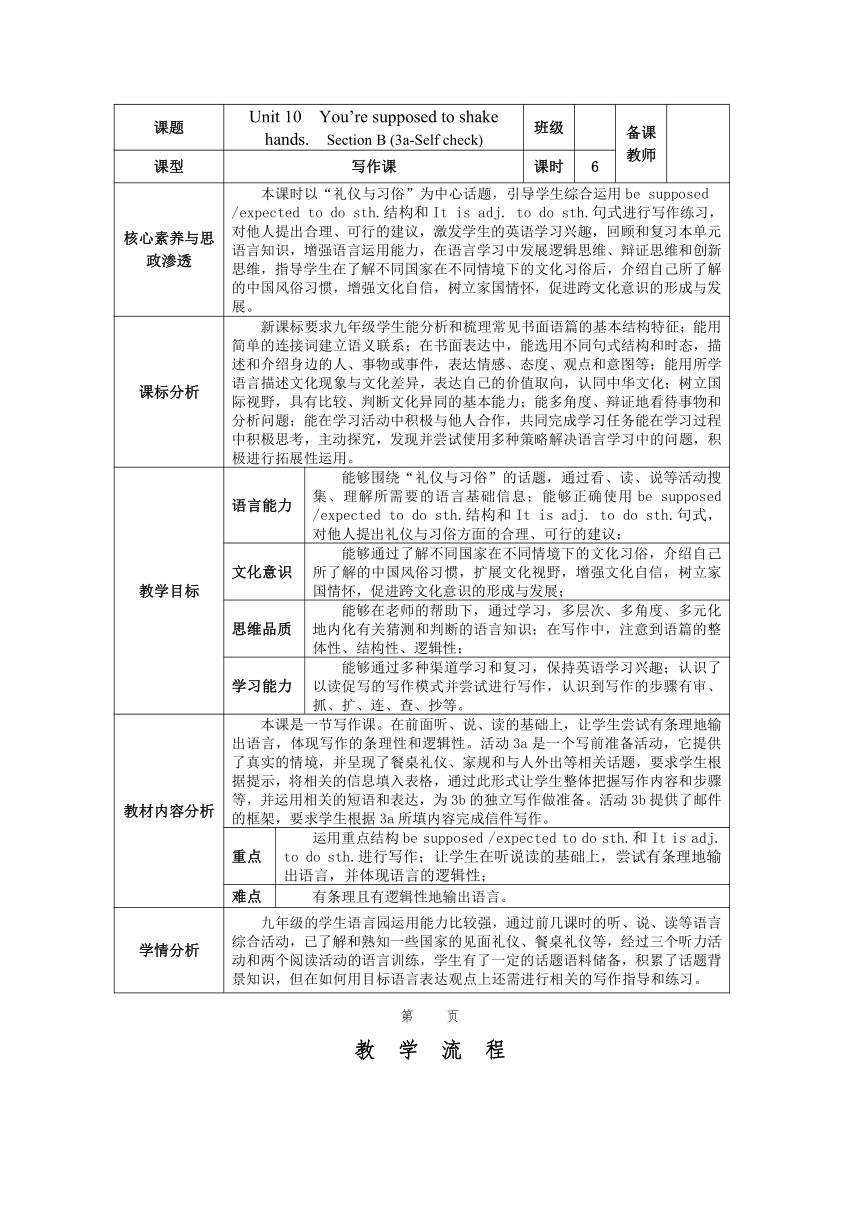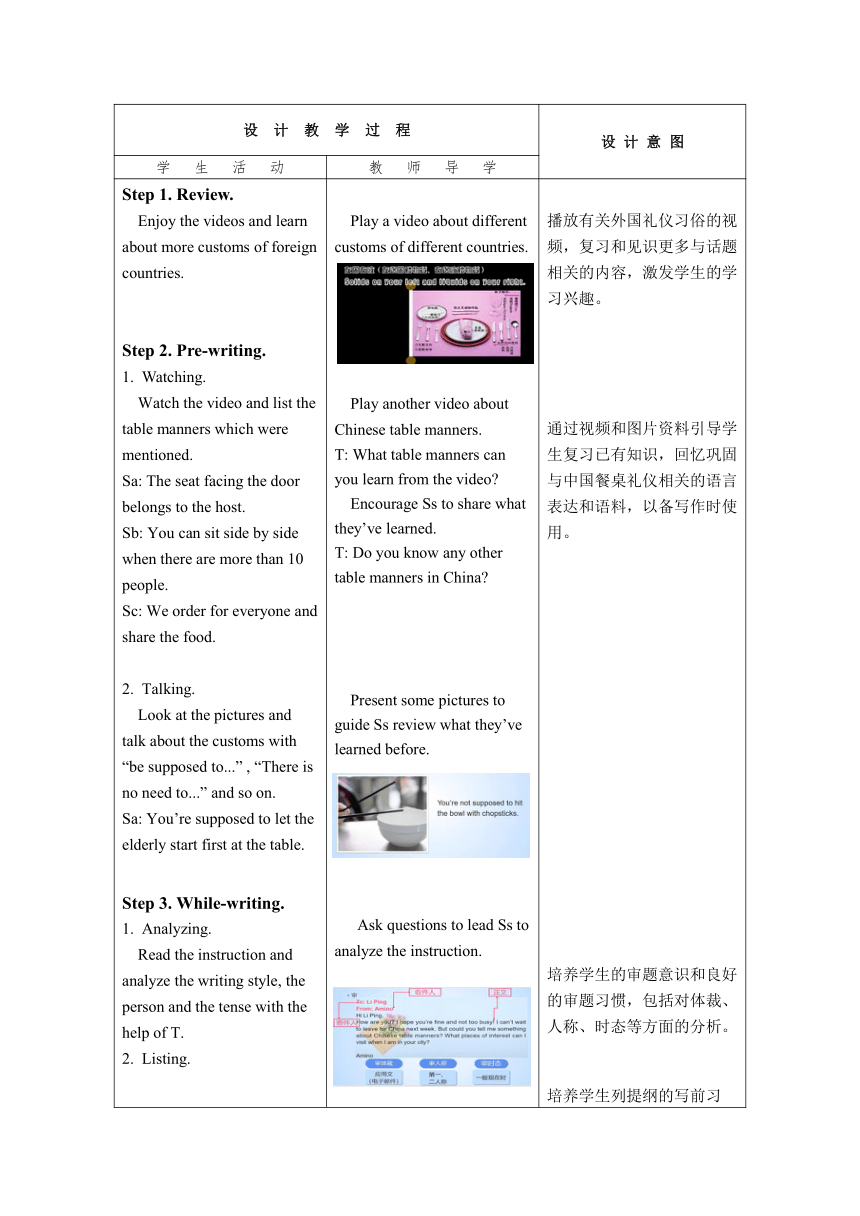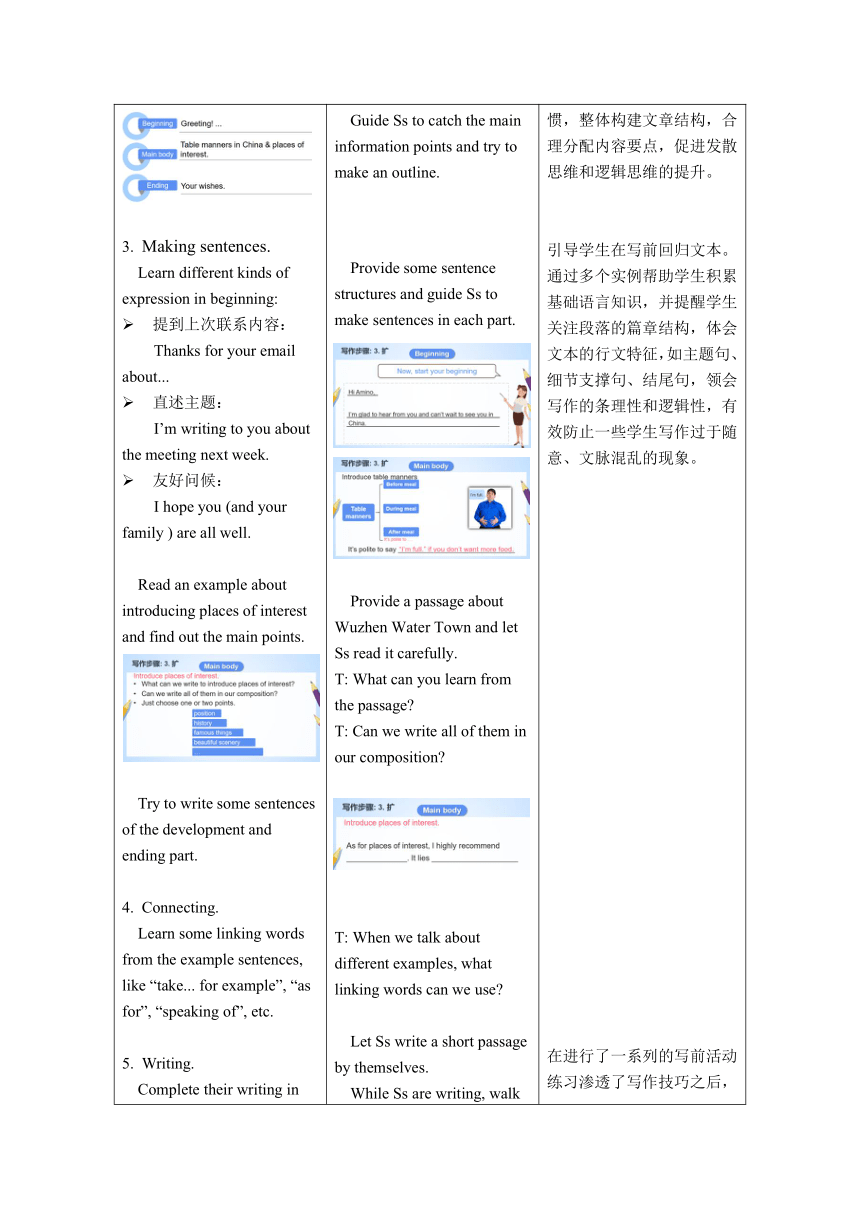【核心素养目标】 Unit 10 You’re supposed to shake hands. Section B (3a-Self check) 表格式教案
文档属性
| 名称 | 【核心素养目标】 Unit 10 You’re supposed to shake hands. Section B (3a-Self check) 表格式教案 |

|
|
| 格式 | docx | ||
| 文件大小 | 581.4KB | ||
| 资源类型 | 教案 | ||
| 版本资源 | 人教新目标(Go for it)版 | ||
| 科目 | 英语 | ||
| 更新时间 | 2024-09-24 14:51:54 | ||
图片预览



文档简介
课题 Unit 10 You’re supposed to shake hands. Section B (3a-Self check) 班级 备课教师
课型 写作课 课时 6
核心素养与思政渗透 本课时以“礼仪与习俗”为中心话题,引导学生综合运用be supposed /expected to do sth.结构和It is adj. to do sth.句式进行写作练习,对他人提出合理、可行的建议,激发学生的英语学习兴趣,回顾和复习本单元语言知识,增强语言运用能力,在语言学习中发展逻辑思维、辩证思维和创新思维,指导学生在了解不同国家在不同情境下的文化习俗后,介绍自己所了解的中国风俗习惯,增强文化自信,树立家国情怀,促进跨文化意识的形成与发展。
课标分析 新课标要求九年级学生能分析和梳理常见书面语篇的基本结构特征;能用简单的连接词建立语义联系;在书面表达中,能选用不同句式结构和时态,描述和介绍身边的人、事物或事件,表达情感、态度、观点和意图等;能用所学语言描述文化现象与文化差异,表达自己的价值取向,认同中华文化;树立国际视野,具有比较、判断文化异同的基本能力;能多角度、辩证地看待事物和分析问题;能在学习活动中积极与他人合作,共同完成学习任务能在学习过程中积极思考,主动探究,发现并尝试使用多种策略解决语言学习中的问题,积极进行拓展性运用。
教学目标 语言能力 能够围绕“礼仪与习俗”的话题,通过看、读、说等活动搜集、理解所需要的语言基础信息;能够正确使用be supposed /expected to do sth.结构和It is adj. to do sth.句式,对他人提出礼仪与习俗方面的合理、可行的建议;
文化意识 能够通过了解不同国家在不同情境下的文化习俗,介绍自己所了解的中国风俗习惯,扩展文化视野,增强文化自信,树立家国情怀,促进跨文化意识的形成与发展;
思维品质 能够在老师的帮助下,通过学习,多层次、多角度、多元化地内化有关猜测和判断的语言知识;在写作中,注意到语篇的整体性、结构性、逻辑性;
学习能力 能够通过多种渠道学习和复习,保持英语学习兴趣;认识了以读促写的写作模式并尝试进行写作,认识到写作的步骤有审、抓、扩、连、查、抄等。
教材内容分析 本课是一节写作课。在前面听、说、读的基础上,让学生尝试有条理地输出语言,体现写作的条理性和逻辑性。活动3a是一个写前准备活动,它提供了真实的情境,并呈现了餐桌礼仪、家规和与人外出等相关话题,要求学生根据提示,将相关的信息填入表格,通过此形式让学生整体把握写作内容和步骤等,并运用相关的短语和表达,为3b的独立写作做准备。活动3b提供了邮件的框架,要求学生根据3a所填内容完成信件写作。
重点 运用重点结构be supposed /expected to do sth.和It is adj. to do sth.进行写作;让学生在听说读的基础上,尝试有条理地输出语言,并体现语言的逻辑性;
难点 有条理且有逻辑性地输出语言。
学情分析 九年级的学生语言园运用能力比较强,通过前几课时的听、说、读等语言综合活动,已了解和熟知一些国家的见面礼仪、餐桌礼仪等,经过三个听力活动和两个阅读活动的语言训练,学生有了一定的话题语料储备,积累了话题背景知识,但在如何用目标语言表达观点上还需进行相关的写作指导和练习。
第 页
教 学 流 程
设 计 教 学 过 程 设 计 意 图
学 生 活 动 教 师 导 学
Step 1. Review. Enjoy the videos and learn about more customs of foreign countries. Step 2. Pre-writing. Watching. Watch the video and list the table manners which were mentioned. Sa: The seat facing the door belongs to the host. Sb: You can sit side by side when there are more than 10 people. Sc: We order for everyone and share the food. Talking. Look at the pictures and talk about the customs with “be supposed to...” , “There is no need to...” and so on. Sa: You’re supposed to let the elderly start first at the table. Step 3. While-writing. Analyzing. Read the instruction and analyze the writing style, the person and the tense with the help of T. Listing. Making sentences. Learn different kinds of expression in beginning: 提到上次联系内容: Thanks for your email about... 直述主题: I’m writing to you about the meeting next week. 友好问候: I hope you (and your family ) are all well. Read an example about introducing places of interest and find out the main points. Try to write some sentences of the development and ending part. Connecting. Learn some linking words from the example sentences, like “take... for example”, “as for”, “speaking of”, etc. plete their writing in 10 minutes.. Step 4. Post-writing. After finish writing, have a self-check for 3 minutes according to the checklist. Then share their passage with partners and evaluate each other according to the evaluation sheet. Appreciate more sample writing and polish theirs. Step 5. Self check. Finish the self check part. Report their answers and talk about their reasons. Play a video about different customs of different countries. Play another video about Chinese table manners. T: What table manners can you learn from the video Encourage Ss to share what they’ve learned. T: Do you know any other table manners in China Present some pictures to guide Ss review what they’ve learned before. Ask questions to lead Ss to analyze the instruction. Guide Ss to catch the main information points and try to make an outline. Provide some sentence structures and guide Ss to make sentences in each part. Provide a passage about Wuzhen Water Town and let Ss read it carefully. T: What can you learn from the passage T: Can we write all of them in our composition T: When we talk about different examples, what linking words can we use Let Ss write a short passage by themselves. While Ss are writing, walk around the classroom to offer help if they need. Offer the evaluation standards to the class. Pick out one or two examples to evaluate in class. Let Ss finish the activities in Self Check. 播放有关外国礼仪习俗的视频,复习和见识更多与话题相关的内容,激发学生的学习兴趣。 通过视频和图片资料引导学生复习已有知识,回忆巩固与中国餐桌礼仪相关的语言表达和语料,以备写作时使用。 培养学生的审题意识和良好的审题习惯,包括对体裁、人称、时态等方面的分析。 培养学生列提纲的写前习惯,整体构建文章结构,合理分配内容要点,促进发散思维和逻辑思维的提升。 引导学生在写前回归文本。通过多个实例帮助学生积累基础语言知识,并提醒学生关注段落的篇章结构,体会文本的行文特征,如主题句、细节支撑句、结尾句,领会写作的条理性和逻辑性,有效防止一些学生写作过于随意、文脉混乱的现象。 在进行了一系列的写前活动练习渗透了写作技巧之后,让学生当堂写作,为其提供实践的机会。 培养学生良好的自我纠正习惯和方法,以及合作精神、批判思维能力和对作品的鉴赏能力。在自我修改和同伴修改的基础上,集思广益,取其精华,学会运用更多的方法把文章写好。 自我检测,总结反思。
第 页
课 时 达 标 检 测
Ⅰ.请阅读下面的非连续性文本,按要求完成所给任务。 When we communicate with others, we express our thoughts and feelings not only through words, but also through our tone of voice, facial expressions and body language. Here is some basic body language: ·the way we greet one another ·how we stand, sit and walk ·the way we use our hands and eyes To learn another language is more than just learning words and grammar. It also includes learning about another culture. Body language in different cultures has different meanings, so second language learners should pay attention to that. Sometimes, cultural differences in body language can cause misunderstandings too. For example, there are cultural differences in how much distance should be kept between two people. If you are used to people keeping their distance, you will feel very uncomfortable when someone keeps trying to stand closer to you. Another example of misunderstanding is the use of a smile. In some Asian cultures, a smile can show embarrassment or apology. However, smiling back at an angry teacher is probably not a good idea in most English-speaking cultures! Cultural differences in body language can lead to misunderstandings: Even speakers of the same language, such as American, Australian or British people, may not use the same body language. Just as you should not allow a fear of making language mistakes to stop you from speaking, you should not be afraid of using inappropriate(不适当的) body language in a different culture. Most people will understand that people from different cultures may not always use body language in the same ways. Knowing how to understand and use body language of different cultures can help improve your communication skills greatly, so it's always worth learning it. 1.Please give two examples of basic body language. 2.Please translate the underlined sentence into Chinese. 3.Please complete the chart. What other cultural differences in body language can cause misunderstandings 4.What can we infer from the three students' words 5.What can we know about Coco 6.Do you think it's useful to learn body language of different cultures Why
课 时 教 学 设 计 尾 页
板 书 设 计
Unit 10 You’re supposed to shake hands. Section B (3a-Self check)
作 业 设 计
Level A Search for more information about table manners in China and make a video or poster for foreign friends.
Level B Draw a mind map to sum up the knowledge of this unit.
教 学 反 思
第 页
课型 写作课 课时 6
核心素养与思政渗透 本课时以“礼仪与习俗”为中心话题,引导学生综合运用be supposed /expected to do sth.结构和It is adj. to do sth.句式进行写作练习,对他人提出合理、可行的建议,激发学生的英语学习兴趣,回顾和复习本单元语言知识,增强语言运用能力,在语言学习中发展逻辑思维、辩证思维和创新思维,指导学生在了解不同国家在不同情境下的文化习俗后,介绍自己所了解的中国风俗习惯,增强文化自信,树立家国情怀,促进跨文化意识的形成与发展。
课标分析 新课标要求九年级学生能分析和梳理常见书面语篇的基本结构特征;能用简单的连接词建立语义联系;在书面表达中,能选用不同句式结构和时态,描述和介绍身边的人、事物或事件,表达情感、态度、观点和意图等;能用所学语言描述文化现象与文化差异,表达自己的价值取向,认同中华文化;树立国际视野,具有比较、判断文化异同的基本能力;能多角度、辩证地看待事物和分析问题;能在学习活动中积极与他人合作,共同完成学习任务能在学习过程中积极思考,主动探究,发现并尝试使用多种策略解决语言学习中的问题,积极进行拓展性运用。
教学目标 语言能力 能够围绕“礼仪与习俗”的话题,通过看、读、说等活动搜集、理解所需要的语言基础信息;能够正确使用be supposed /expected to do sth.结构和It is adj. to do sth.句式,对他人提出礼仪与习俗方面的合理、可行的建议;
文化意识 能够通过了解不同国家在不同情境下的文化习俗,介绍自己所了解的中国风俗习惯,扩展文化视野,增强文化自信,树立家国情怀,促进跨文化意识的形成与发展;
思维品质 能够在老师的帮助下,通过学习,多层次、多角度、多元化地内化有关猜测和判断的语言知识;在写作中,注意到语篇的整体性、结构性、逻辑性;
学习能力 能够通过多种渠道学习和复习,保持英语学习兴趣;认识了以读促写的写作模式并尝试进行写作,认识到写作的步骤有审、抓、扩、连、查、抄等。
教材内容分析 本课是一节写作课。在前面听、说、读的基础上,让学生尝试有条理地输出语言,体现写作的条理性和逻辑性。活动3a是一个写前准备活动,它提供了真实的情境,并呈现了餐桌礼仪、家规和与人外出等相关话题,要求学生根据提示,将相关的信息填入表格,通过此形式让学生整体把握写作内容和步骤等,并运用相关的短语和表达,为3b的独立写作做准备。活动3b提供了邮件的框架,要求学生根据3a所填内容完成信件写作。
重点 运用重点结构be supposed /expected to do sth.和It is adj. to do sth.进行写作;让学生在听说读的基础上,尝试有条理地输出语言,并体现语言的逻辑性;
难点 有条理且有逻辑性地输出语言。
学情分析 九年级的学生语言园运用能力比较强,通过前几课时的听、说、读等语言综合活动,已了解和熟知一些国家的见面礼仪、餐桌礼仪等,经过三个听力活动和两个阅读活动的语言训练,学生有了一定的话题语料储备,积累了话题背景知识,但在如何用目标语言表达观点上还需进行相关的写作指导和练习。
第 页
教 学 流 程
设 计 教 学 过 程 设 计 意 图
学 生 活 动 教 师 导 学
Step 1. Review. Enjoy the videos and learn about more customs of foreign countries. Step 2. Pre-writing. Watching. Watch the video and list the table manners which were mentioned. Sa: The seat facing the door belongs to the host. Sb: You can sit side by side when there are more than 10 people. Sc: We order for everyone and share the food. Talking. Look at the pictures and talk about the customs with “be supposed to...” , “There is no need to...” and so on. Sa: You’re supposed to let the elderly start first at the table. Step 3. While-writing. Analyzing. Read the instruction and analyze the writing style, the person and the tense with the help of T. Listing. Making sentences. Learn different kinds of expression in beginning: 提到上次联系内容: Thanks for your email about... 直述主题: I’m writing to you about the meeting next week. 友好问候: I hope you (and your family ) are all well. Read an example about introducing places of interest and find out the main points. Try to write some sentences of the development and ending part. Connecting. Learn some linking words from the example sentences, like “take... for example”, “as for”, “speaking of”, etc. plete their writing in 10 minutes.. Step 4. Post-writing. After finish writing, have a self-check for 3 minutes according to the checklist. Then share their passage with partners and evaluate each other according to the evaluation sheet. Appreciate more sample writing and polish theirs. Step 5. Self check. Finish the self check part. Report their answers and talk about their reasons. Play a video about different customs of different countries. Play another video about Chinese table manners. T: What table manners can you learn from the video Encourage Ss to share what they’ve learned. T: Do you know any other table manners in China Present some pictures to guide Ss review what they’ve learned before. Ask questions to lead Ss to analyze the instruction. Guide Ss to catch the main information points and try to make an outline. Provide some sentence structures and guide Ss to make sentences in each part. Provide a passage about Wuzhen Water Town and let Ss read it carefully. T: What can you learn from the passage T: Can we write all of them in our composition T: When we talk about different examples, what linking words can we use Let Ss write a short passage by themselves. While Ss are writing, walk around the classroom to offer help if they need. Offer the evaluation standards to the class. Pick out one or two examples to evaluate in class. Let Ss finish the activities in Self Check. 播放有关外国礼仪习俗的视频,复习和见识更多与话题相关的内容,激发学生的学习兴趣。 通过视频和图片资料引导学生复习已有知识,回忆巩固与中国餐桌礼仪相关的语言表达和语料,以备写作时使用。 培养学生的审题意识和良好的审题习惯,包括对体裁、人称、时态等方面的分析。 培养学生列提纲的写前习惯,整体构建文章结构,合理分配内容要点,促进发散思维和逻辑思维的提升。 引导学生在写前回归文本。通过多个实例帮助学生积累基础语言知识,并提醒学生关注段落的篇章结构,体会文本的行文特征,如主题句、细节支撑句、结尾句,领会写作的条理性和逻辑性,有效防止一些学生写作过于随意、文脉混乱的现象。 在进行了一系列的写前活动练习渗透了写作技巧之后,让学生当堂写作,为其提供实践的机会。 培养学生良好的自我纠正习惯和方法,以及合作精神、批判思维能力和对作品的鉴赏能力。在自我修改和同伴修改的基础上,集思广益,取其精华,学会运用更多的方法把文章写好。 自我检测,总结反思。
第 页
课 时 达 标 检 测
Ⅰ.请阅读下面的非连续性文本,按要求完成所给任务。 When we communicate with others, we express our thoughts and feelings not only through words, but also through our tone of voice, facial expressions and body language. Here is some basic body language: ·the way we greet one another ·how we stand, sit and walk ·the way we use our hands and eyes To learn another language is more than just learning words and grammar. It also includes learning about another culture. Body language in different cultures has different meanings, so second language learners should pay attention to that. Sometimes, cultural differences in body language can cause misunderstandings too. For example, there are cultural differences in how much distance should be kept between two people. If you are used to people keeping their distance, you will feel very uncomfortable when someone keeps trying to stand closer to you. Another example of misunderstanding is the use of a smile. In some Asian cultures, a smile can show embarrassment or apology. However, smiling back at an angry teacher is probably not a good idea in most English-speaking cultures! Cultural differences in body language can lead to misunderstandings: Even speakers of the same language, such as American, Australian or British people, may not use the same body language. Just as you should not allow a fear of making language mistakes to stop you from speaking, you should not be afraid of using inappropriate(不适当的) body language in a different culture. Most people will understand that people from different cultures may not always use body language in the same ways. Knowing how to understand and use body language of different cultures can help improve your communication skills greatly, so it's always worth learning it. 1.Please give two examples of basic body language. 2.Please translate the underlined sentence into Chinese. 3.Please complete the chart. What other cultural differences in body language can cause misunderstandings 4.What can we infer from the three students' words 5.What can we know about Coco 6.Do you think it's useful to learn body language of different cultures Why
课 时 教 学 设 计 尾 页
板 书 设 计
Unit 10 You’re supposed to shake hands. Section B (3a-Self check)
作 业 设 计
Level A Search for more information about table manners in China and make a video or poster for foreign friends.
Level B Draw a mind map to sum up the knowledge of this unit.
教 学 反 思
第 页
同课章节目录
- Unit 1 How can we become good learners.
- Section A
- Section B
- Unit 2 I think that mooncakes are delicious!
- Section A
- Section B
- Unit 3 Could you please tell me where the restroom
- Section A
- Section B
- Unit 4 I used to be afraid of the dark.
- Section A
- Section B
- Unit 5 What are the shirts made of?
- Section A
- Section B
- Review of Units 1-5
- Unit 6 When was it invented?
- Section A
- Section B
- Unit 7 Teenagers should be allowed to choose their
- Section A
- Section B
- Unit 8 It must belong to Carla.
- Section A
- Section B
- Unit 9 I like music that I can dance to.
- Section A
- Section B
- Unit 10 You're supposed to shake hands.
- Section A
- Section B
- Review of Units 6-10
- Unit 11 Sad movies make me cry.
- Section A
- Section B
- Unit 12 Life is full of the unexpected
- Section A
- Section B
- Unit 13 We're trying to save the earth!
- Section A
- Section B
- Unit 14 I remember meeting all of you in Grade 7.
- Section A
- Section B
- Review of Units 11-14
